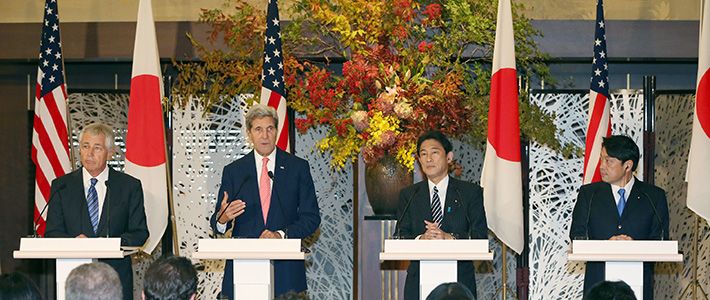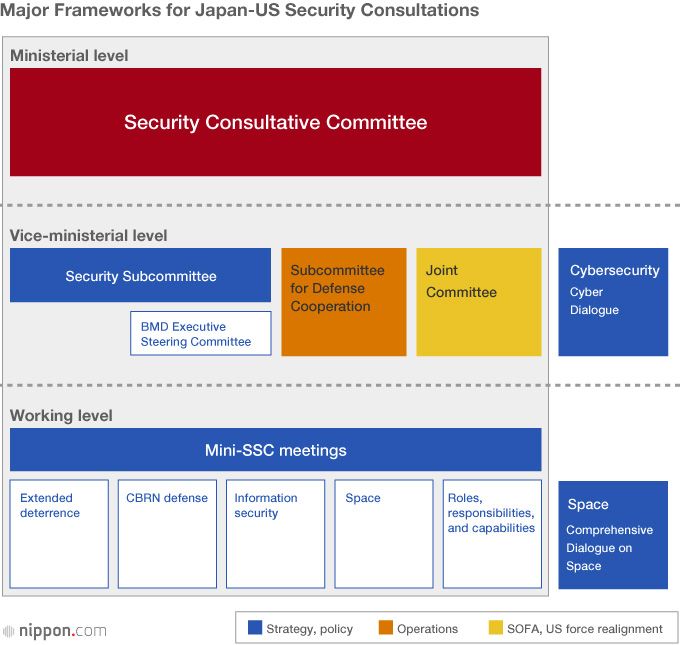
The Japan-US Security Partnership: An Overview
Politics- English
- 日本語
- 简体字
- 繁體字
- Français
- Español
- العربية
- Русский
US President Barack Obama’s visit to Japan on April 23–25, 2014, reconfirmed the two countries’ strong alliance. During their meeting, Obama and Japanese Prime Minister Abe Shinzō also agreed to boost cooperation on security and defense to maintain peace and stability in the Asia-Pacific region.
The United States has recently been pressed by debt woes into slashing its military spending while China, an increasingly important economic partner, is calling for a new kind of major-power relationship between the countries. As Chinese strength grows in East Asia, Washington’s influence on Beijing is waning. When China unilaterally established an Air Defense Identification Zone over an area including Japan’s Senkaku Islands in the East China Sea last year, there was a noticeable gap in the intensity of the reactions from Tokyo and Washington. This led some Japanese and international observers to fear that the bilateral alliance, essential to Japan’s security, was weakening. However, cooperation at a practical level is actually expanding, in sharp contrast with the image given by top-level statements and government announcements.
“Two-Plus-Two” Plays a Central Role
The Japan-US security partnership has become closer in the past few years as North Korean missile launches and nuclear tests and Chinese offensive moves around the Senkaku Islands have prompted increased defense cooperation. The Japan-US Security Consultative Committee, commonly known as “two-plus-two” for its membership of the Japanese foreign and defense ministers and the US secretaries of state and defense, plays a central role in the partnership.
The SCC has been responsible for a number of key moves in the bilateral security relationship, including the 1996, establishment of the Special Action Committee on Okinawa, an agreement on consolidation and reduction of US military bases on the island, and the 1997 revision of the Guidelines for Japan-US Defense Cooperation. At the most recent two-plus-two talks, held on October 3, 2013, the sides agreed to revise the Defense Guidelines again by the end of 2014 and to expand collaboration in 15 areas, including cybersecurity and space. The committee also pledged to push ahead with realignment of US forces in Japan.
Five Vice-Ministerial Frameworks
At the vice-ministerial level, there are five frameworks for consultation: the Security Subcommittee, the Joint Committee, the Subcommittee for Defense Cooperation, the Ballistic Missile Defense Executive Steering Committee, and the Cyber Dialogue.
The Security Subcommittee discusses major security issues. On the Japanese side, members include the Japanese director generals of the Ministry of Foreign Affairs’ North American Affairs Bureau and the Ministry of Defense’s Bureau of Defense Policy. The American participants include the assistant secretaries of state and defense.
The Joint Committee cooperates as necessary in implementing SOFA, the Status of Forces Agreement. Japanese members include the director generals of MOFA’s North American Affairs Bureau and MOD’s Bureau of Local Cooperation; US members include the deputy chief of mission at the US Embassy in Tokyo and the deputy commander of US forces in Japan.
The Subcommittee for Defense Cooperation is a framework for study and consultation on guidelines needed for emergency joint response from Japanese and US forces and on other matters related to defense cooperation. Japanese members include the director generals of MOFA’s North American Affairs Bureau and MOD’s Bureau of Defense Policy and Bureau of Operational Policy, as well as representatives of the Joint Staff Office. US members include the assistant secretaries of state and defense and representatives from the US Embassy, US forces in Japan, the Joint Chiefs of Staff, and the US Pacific Command.
The Ballistic Missile Defense Executive Steering Committee is a consultation body for cooperation between the allies’ defense authorities that aims to mutually clarify systems, roles, and duties for the implementation of ballistic missile defense and related strategies.
The Cyber Dialogue, which convened for the first time in May 2013, is a consultative body for bilateral cooperation through exchange of information about international threats in cyberspace, development of concrete methods to protect infrastructure, and creation of international rules.
A Range of Working Committees
Working committees also meet when necessary to draw up specific policy based on discussions by ministerial and vice-ministerial committees. These are known as “mini-SSC” meetings, named after the main Security Subcommittee. They cover the following five areas: extended deterrence; chemical, biological, radiological, and nuclear defense; information security; space; and roles, responsibilities, and capabilities.
The Comprehensive Dialogue on Space has also been held since 2013. Here discussions cover topics ranging from resource and disaster management to environmental monitoring, scientific discovery, and national and international security.
In the light of these new cooperative efforts, President Obama’s visit to Japan should be seen as reaffirming and underlining the American interest in East Asian security.

(Banner photo: Defense Secretary Chuck Hagel and Secretary of State John Kerry stand with Minister for Foreign Affairs Kishida Fumio and Minister of Defense Onodera Itsunori following the two-plus-two meeting on October 3, 2013. Photo courtesy Jiji Press.)
United States security China Abe Shinzō Barack Obama foreign relations summit defense